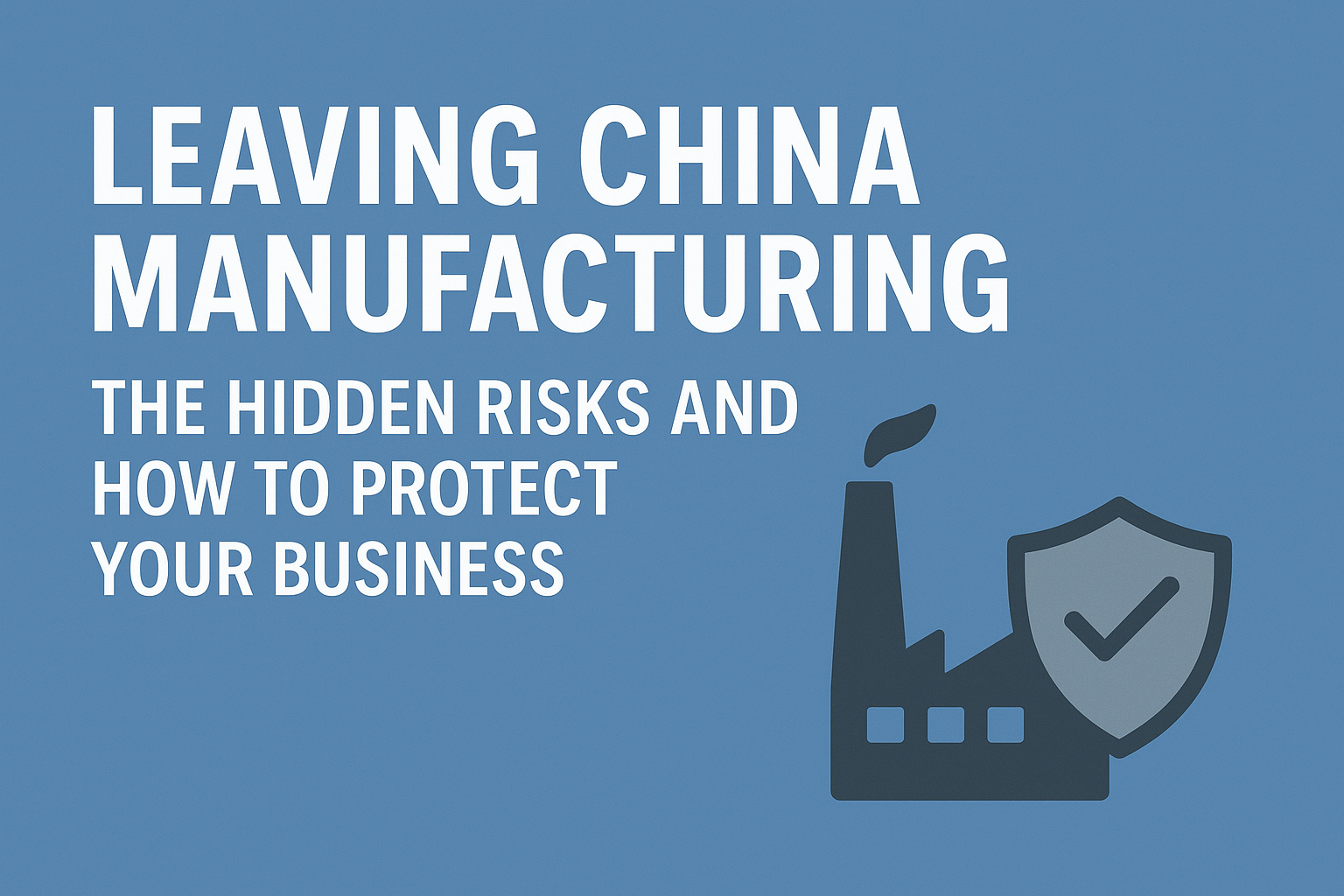Over the past few years, many companies have been rethinking China, and looking to reduce their reliance on China manufacturing. Some are shifting production to Southeast Asia, others to Mexico, and some are re-shoring to the United States
Most businesses understand that setting up manufacturing in a new country comes with its own challenges. What fewer realize is that reducing your footprint in China—or leaving entirely—can create a whole new set of risks, often more immediate, personal, and costly than those in your new market.
This post explains the key risks of leaving China, how to prepare a safe China manufacturing exit strategy, and what steps you should take to protect your company, your assets, and your IP in your new manufacturing country.

Why Leaving China Can Put You in the Crosshairs
If you’re planning to move manufacturing out of China, your exit’s success will depend heavily on your approach, your history with suppliers, and your operational footprint. Once word spreads about a departure, even previously cooperative partners may turn hostile—often seeking to extract money, assets, or leverage.
Hostage-Taking
Yes, this still happens in China. In 2021, I co-wrote Commercial hostages in international business disputes, which explains how Chinese companies detain foreign executives to collect alleged debts, protest layoffs, or fight facility closures.
If you are closing a facility or laying off workers in China, do not assume you are safe on the ground in China.
At a minimum, you should Avoid traveling to China during the transition. If you or your executives are already there, leave promptly. If travel is unavoidable, hire professional security and control the location and circumstances of your meetings. For instance, do not meet in the factory of your supplier who claims that you owe it $800,000. See How to Reduce Your Chances of Getting Kidnapped in China.
Fake or “Resurrected” Debts
Once you signal—intentionally or not—that you’re reducing your China footprint, you may face a wave of sudden claims:
· Tax authorities demanding unpaid or reassessed taxes.
· Landlords claiming additional rent or inflated repair costs.
· Suppliers invoicing for undelivered goods or long-settled disputes.
· Employees seeking exaggerated severance, back pay, or unused vacation payouts.
It’s common for multiple claims to arrive at the same time, forcing you to either spend heavily to defend yourself or settle to move forward.
Some companies avoid this by shutting down operations abruptly and disappearing, but that approach only works if you are certain your business will never operate in or with China again—and that no executives will find themselves in China, Hong Kong, or Macao even by accident.
Common Supplier Retaliation Tactics
When a foreign company announces its plan to move production elsewhere, certain Chinese manufacturers may retaliate by engaging in the following tactics:
1. Tooling and Mold Seizure – Claiming ownership and refusing to release them.
2. IP Hijacking – Registering your trademarks or logos in China through third parties.
3. Customs Seizures – Blocking your goods for alleged IP infringement.
4. Product Ransom – Refusing to ship goods you’ve already paid for until you pay “debts,” then reporting you to Sinosure.
Risk Factors for Retaliation
Your chances of facing retaliation rise significantly if you have:
· 50 or more local employees.
· Substantial outstanding supply or service contracts.
· Suppliers heavily dependent on your business.
· Public announcements about your relocation.
· A history of strained relationships with suppliers or officials.
Companies with smaller footprints, diversified supplier bases, and a quiet departure plan generally face fewer problems.
How to Mitigate Your China Exit Risks
A safe China manufacturing exit strategy requires advance planning, discretion, and legal preparation.
Essential steps:
· Secure all molds, tooling, and paid-for products before hinting at your departure.
· Register all relevant IP in China—even if you are leaving—to prevent others from doing so first. See China Trademarks: Register Yours BEFORE You Do ANYTHING Else.
· Obtain clear financial statements confirming zero outstanding debts, taxes, or salaries.
· Use airtight contracts with suppliers, landlords, and employees confirming asset ownership and payment status. If your contracts do not protect your IP from China, consider entering into new contracts before you leave China.
· Remove foreign personnel from China well before the announcement that you will be leaving.
Keep your departure plans strictly confidential until all critical protections are in place.
Protecting Your Business in Your New Manufacturing Country
Relocating production offers the chance to start fresh—but only if you protect yourself from day one.
1. Conduct Due Diligence
Investigate your new manufacturer’s finances, reputation, and litigation history. Work with a local law firm to ensure accuracy and depth. See Foreign Company Due Diligence Reports.
2. Use Protective Contracts
The right country-specific contracts are your first line of defense. Before you even think about sharing sensitive information or sending a deposit, you should have these essential agreements in place:
· NNN Agreement – For discussions with potential suppliers before you share sensitive information.
· Manufacturing Agreement – Clearly defines product specs, quality control, delivery schedules, payment terms, and IP protections before you send any money.
3. Register IP in the New Jurisdiction and Target Markets
Secure trademarks, patents, and copyrights in your manufacturing country and your sales destinations. Registering with customs authorities can help prevent counterfeit shipments.
Conclusion
Leaving China manufacturing is not a simple supply chain decision—it’s a legal, operational, and reputational challenge. Poorly planned exits can cost companies millions in seized assets, lost IP, and damaged business relationships.
Plan early, act quietly, and secure every legal and operational safeguard before you make a single public move. Done right, a China manufacturing exit can position your business for a safer, more stable future in its new location.
* Original article published here. *

